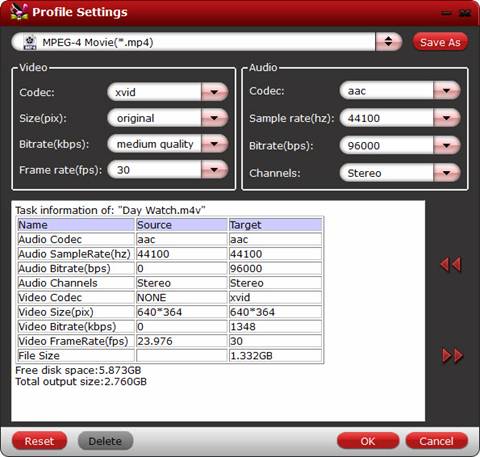The software saves converted videos to default path if you don’t specify an output folder. Click “Browse” button to specify output location where you’d like to export video/audio files to.

Use a preset format
Click “Format” bar to select output file format. There are various video and audio formats for you to choose from. Select a desired format from the list, and then you can step into the conversion process. 
If you don’t want to see so many formats in profile list, click “Customize” to hide templates that are rarely used.
Use custom format
When/If the preset formats do not meet you needs, you can customize a format by yourself. Simply select a format and click “Settings”. 
- Video Codec is used to compress the digital video contents. Movies on the iTunes Store use the H.264 codec exclusively.
- Video Size refers to the physical number of columns and rows of pixels creating the display (e.g., 1920×1080). Apple defined that iTunes Store video use 640×480 for SD and 1280×720 for HD contents. 1920×1080 is NOT recommended for converting, as this may lead to audio and video sync issues.
Video Bitrate refers to the number of bits that are conveyed per unit of time (data transfer rate). Set video bitrate up to improve video quality. - Video Frame rate is the rate at which sequential frames are presented. Frame rate varies according to the video standard in use. In North America and Japan, 30 frames per second is the broadcast standard, with 24fps now common in production for high-definition video.
- Audio codec is used to compress the audio contents.
- Audio Sample rate defines the number of samples per unit of time (usually seconds) taken from a continuous signal to make a discrete signal. In digital audio the most common sampling rates are 44.1 kHz, 48 kHz, and 96 kHz.
- Audio Bitrate refers to the data transfer rate of audio contents.
- Audio Channels refers to the passages for audio streams to pass-through. A stereo audio has two independent channels, one left and one right while mono has one channel only. A 5.1 system provides front left, center and right, surround left and right and subwoofer. When listen to music from earphone or handset, stereo audio is just fine.
Save As: click to save your settings as a new format. The next time you run ChewTune, you can
click the format bar and find the format in "Custom" group.
Reset: click to restore default settings.

 Home
Home





